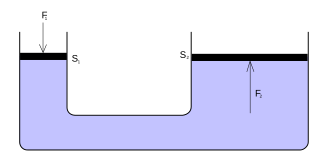
In physics and engineering, fluid dynamics is a subdiscipline of fluid mechanics that describes the flow of fluids—liquids and gases. It has several subdisciplines, including aerodynamics and hydrodynamics. Fluid dynamics has a wide range of applications, including calculating forces and moments on aircraft, determining the mass flow rate of petroleum through pipelines, predicting weather patterns, understanding nebulae in interstellar space and modelling fission weapon detonation.
A non-Newtonian fluid is a fluid that does not follow Newton's law of viscosity, i.e., constant viscosity independent of stress. In non-Newtonian fluids, viscosity can change when under force to either more liquid or more solid. Ketchup, for example, becomes runnier when shaken and is thus a non-Newtonian fluid. Many salt solutions and molten polymers are non-Newtonian fluids, as are many commonly found substances such as custard, toothpaste, starch suspensions, corn starch, paint, blood, melted butter, and shampoo.

Cutting fluid is a type of coolant and lubricant designed specifically for metalworking processes, such as machining and stamping. There are various kinds of cutting fluids, which include oils, oil-water emulsions, pastes, gels, aerosols (mists), and air or other gases. Cutting fluids are made from petroleum distillates, animal fats, plant oils, water and air, or other raw ingredients. Depending on context and on which type of cutting fluid is being considered, it may be referred to as cutting fluid, cutting oil, cutting compound, coolant, or lubricant.

Metalworking is the process of shaping and reshaping metals to create useful objects, parts, assemblies, and large scale structures. As a term it covers a wide and diverse range of processes, skills, and tools for producing objects on every scale: from huge ships, buildings, and bridges down to precise engine parts and delicate jewelry.
A Newtonian fluid is a fluid in which the viscous stresses arising from its flow are at every point linearly correlated to the local strain rate — the rate of change of its deformation over time. Stresses are proportional to the rate of change of the fluid's velocity vector.

Fluid power is the use of fluids under pressure to generate, control, and transmit power. Fluid power is subdivided into hydraulics using a liquid such as mineral oil or water, and pneumatics using a gas such as air or other gases. Compressed-air and water-pressure systems were once used to transmit power from a central source to industrial users over extended geographic areas; fluid power systems today are usually within a single building or mobile machine.
Fluid mechanics is the branch of physics concerned with the mechanics of fluids and the forces on them. It has applications in a wide range of disciplines, including mechanical, civil, chemical and biomedical engineering, geophysics, oceanography, meteorology, astrophysics, and biology.
Mycobacteroides immunogenum is a species of bacteria from the phylum Actinomycetota, belonging to the genus Mycobacteroides.

Motorex-Bucher Group AG is a Swiss family-owned company specializing in the development, production and marketing of lubricants, metalworking fluids, technical cleaning and care products as well as fluid equipment. The product range comprises more than 2,500 formulations and is continuously developed in cooperation with users, manufacturers (OEMs), industrial partners, motorsport teams as well as universities and research institutes.

The viscosity of a fluid is a measure of its resistance to deformation at a given rate. For liquids, it corresponds to the informal concept of "thickness": for example, syrup has a higher viscosity than water.
Pseudochrobactrum lubricantis is a Gram-negative, oxidase-positive, non-spore-forming, rod-shaped, nonmotile bacterium of the genus Paenochrobactrum, which was isolated from water mixed metal-working fluid in Germany.
Tessaracoccus is a Gram-positive, non-spore-forming, facultatively anaerobic and non-motile bacterial genus from the family Propionibacteriaceae.
Tessaracoccus flavescens is a Gram-positive, anaerobic, non-spore-forming and non-motile bacterium from the genus Tessaracoccus which has been isolated from beach sediments from Jeju, Korea.
Tessaracoccus rhinocerotis is a Gram-positive, non-spore-forming, facultatively anaerobic and non-motile bacterium from the genus Tessaracoccus which has been isolated from the faeces of the rhino from the Yunnan Wild Animal Park in China.
Tessaracoccus coleopterorum is a Gram-positive, coccus-shaped, facultatively anaerobic and non-motile bacterium from the genus Tessaracoccus which has been isolated from the intestine of a dark diving beetle.
Tessaracoccus antarcticus is a Gram-positive and facultatively anaerobic bacterium from the genus Tessaracoccus which has been isolated from soil from the Fildes Peninsula. Tessaracoccus antarcticus produces rhodopsin.
Tessaracoccus aquimaris is a Gram-positive, aerobic and non-motile bacterium from the genus Tessaracoccus which has been isolated from the intestine of the rockfish Sebastes schlegelii from a marine aquaculture pond.
"Tessaracoccus massiliensis" is a Gram-positive, facultatively anaerobic, rod-shaped, non-spore-forming and non-motile bacterium from the genus Tessaracoccus which has been isolated from the human gut of a Nigerian child suffering from kwashiorkor.
Tessaracoccus terricola is a Gram-positive, rod-shaped and non-motile bacterium from the genus of Tessaracoccus which has been isolated from soil which was contaminated with oil.
"Tessaracoccus timonensis" is a Gram-negative and non-motile bacterium from the genus Tessaracoccus which has been isolated from vaginal swabs from Senegalese women.





